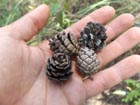
Illustration of principal features (Figure 1 from Pérez de la Rosa and Gernandt 2017).

Tree in habitat, Jalisco [Dante Figueroa, 2019].

Crown of tree in habitat, Jalisco [Dante Figueroa, 2019].

Foliar units, branches, and seed cones in upper crown [Dante Figueroa, 2019].

Foliar units, branches, and seed cones in lower crown [Dante Figueroa, 2019].

Typical seed cones [Dante Figueroa, 2019].

Photographs comparing cones and seeds of Pinus jaliscana, P. oocarpa, and P. vallartensis (Figure 3 from Pérez de la Rosa and Gernandt 2017).

Map showing known occurrences (Figure 2 from Pérez de la Rosa and Gernandt 2017).

Sapling in habitat, Jalisco [Dante Figueroa, 2019].

Conservation Status

Pinus vallartensis
Pérez de la Rosa and Gernandt 2017
Common names
Taxonomic notes
Type: Mexico, Jalisco, Municipio de Puerto Vallarta, 20.53153°N, 105.24494°W, 423m, 2016.09.17, J. A. Pérez de la Rosa and D. Gernandt 2134; holotype IBUG!, isotype MEXU!
This is a member of the large and diverse subsection Australes. The species is a narrow endemic and seems not to have been collected prior to its description; if seen, it was likely ascribed to the similar and sympatric congeners, P. jaliscana or P. oocarpa.
Description
Trees (6-)8-12(-18) m tall and 30-50 cm dbh, with a large open crown extending 25% to 50% of the tree's height. Bark on mature trees 2-4 cm thick, reddish-brown weathering a light gray, in rectangular plates. Leaves in fascicles of (3-)5, lax, light green, finely serrate, (12-)17-20(-22) cm × 0.8-0.9 mm with 3-4(-5) rows of stomata on the outer face and 2-3 on each of the inner faces; persisting 2-3 years, rarely more. Pollen cones 11-27 × 4-6 mm, brown to yellow-brown. Seed cones ovoid, solitary or in pairs, (2.2-)2.5-3(-4) × (2.6-)3.1-3.5(-4) cm when open, on stalks 0.8-1.8 cm × 3-5.5 mm, persistent, falling with the cone; seed scales 34-53 per cone, yellowish brown, lustrous. Seeds dark brown to yellow-brown, 5.3-7.3 × 3.4-4 mm, with wings 12-15 × 3-5 mm. Cotyledons 4-7. Pollination occurs in August and September, and seeds are dispersed in March and April, germinating in May or June soon after the seasonal rains begin (Pérez de la Rosa and Gernandt 2017).
Resembles Pinus oocarpa and P. jaliscana, but has lax leaves and smaller seed cones (see photo) that range in length from (2.2-)2.5-3(-4.0) cm (Pérez de la Rosa and Gernandt 2017).
Distribution and Ecology
At the time of description, this appears to be quite a narrow endemic; of 8 recorded occurrences, 5 are in the southern Municipio de Puerto Vallarta and the others are within 2 km of the Municipio. Elevations are from 380 to 1347 m, and the trees primarily occur on deep acidic soils, on northern exposures. Average annual precipitation is 1200 mm and temperature 26°C. A common associate is Muhlenbergia distichophylla, which is associated with high fire frequencies. Other associates include Byrsonima crassifolia, Quercus aristata, Q. elliptica, Q. magnoliifolia, and Bejaria mexicana. At more humid sites such as along stream banks it occurs with Magnolia vallartensis and Clusia salvinii. Its distribution meets P. oocarpa at its southern limit and P. maximinoi and P. jaliscana near its western limit (Pérez de la Rosa and Gernandt 2017).
Remarkable Specimens
Ethnobotany
Observations
Have not seen in the field, but Pérez de la Rosa and Gernandt (2017) provide sufficient detail that it should be easy to locate.
Remarks
The epithet commemorates the type locale, Puerto Vallarta, Jalisco.
Citations
Pérez de la Rosa, Jorge A. and David S. Gernandt. 2017. Pinus vallartensis (Pinaceae), a new species from western Jalisco, Mexico. Phytotaxa 331(2):233-242 (p. 234).
See also









